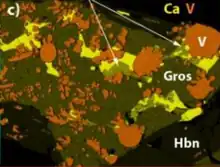| Grossite | |
|---|---|
 | |
| General | |
| Category | Oxide minerals |
| Formula (repeating unit) | CaAl4O7 |
| IMA symbol | Gss[1] |
| Strunz classification | 4.CC.15 |
| Dana classification | 07.03.02.01 |
| Crystal system | Monoclinic |
| Crystal class | Prismatic (2/m) (same H-M symbol) |
| Space group | C2/c |
| Unit cell | a = 12.94, b = 8.91 c = 5.44 [Å]; β = 107.01°; Z = 4 |
| Identification | |
| Color | Colorless to white |
| Crystal habit | Lathlike or subhedral rounded grains in polycrystalline aggregates rimmed by melilite (in meteorites) |
| Luster | Vitreous |
| Streak | White |
| Diaphaneity | Transparent |
| Specific gravity | 2.88 |
| Optical properties | Biaxial (+) |
| Refractive index | nα = 1.618 nβ = 1.618 nγ = 1.652 |
| Birefringence | δ = 0.034 |
| 2V angle | Measured: 15° |
| References | [2][3][4] |
Grossite is a calcium aluminium oxide mineral with formula CaAl4O7. It is a colorless to white vitreous mineral which crystallizes in the monoclinic crystal system.[3][4]
Grossite was first described 1994 for an occurrence in the Hatrurim Formation of Israel. It was named for Shulamit Gross (1923–2012) of the Geological Survey of Israel.[2][4]
It occurs within high temperature metamorphosed impure limestone of the Hatrurim Formation and also within calcium-aluminium rich inclusions in chondritic meteorites. Associated minerals in the Hatrurium include brownmillerite, mayenite and larnite. In meteorites it occurs with perovskite, melilite, hibonite, spinel and calcium rich pyroxene.[2]
See also
References
- ↑ Warr, L.N. (2021). "IMA–CNMNC approved mineral symbols". Mineralogical Magazine. 85 (3): 291–320. Bibcode:2021MinM...85..291W. doi:10.1180/mgm.2021.43. S2CID 235729616.
- 1 2 3 Handbook of Mineralogy
- 1 2 Mindat.org
- 1 2 3 Webmineral data
This article is issued from Wikipedia. The text is licensed under Creative Commons - Attribution - Sharealike. Additional terms may apply for the media files.